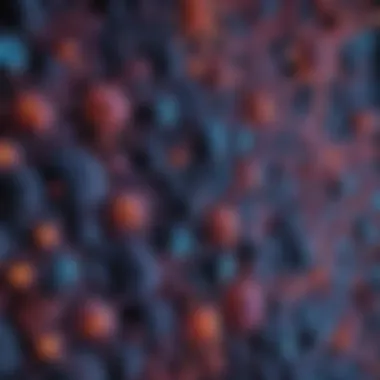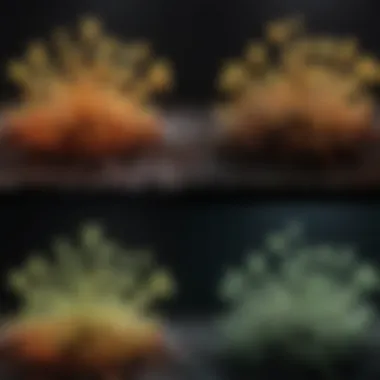Fluorescence Microscopy: Techniques and Innovations


Intro
Fluorescence microscopy has revolutionized the landscape of biological research by enabling scientists to visualize cellular structures and processes with remarkable clarity. This technique harnesses the properties of fluorescent molecules—often referred to as fluorophores—that absorb light at a specific wavelength and emit it at another, longer wavelength. Through this process, researchers can trace and study dynamic activities at a cellular and even molecular level. With applications spanning across a multitude of disciplines, from cellular biology to materials science, fluorescence microscopy plays a crucial role in unraveling complex biological phenomena.
In the sections that follow, we will delve into the methodologies employed in fluorescence microscopy, detailing the various research techniques, tools, and technologies used within this field. Following this, a discussion will shed light on the significance of these innovations, comparing them with previous research and exploring their theoretical implications. Understanding these aspects is essential for appreciating the advancements in this domain and their relevance to contemporary scientific inquiry.
Prelims to Fluorescence Microscopy
Fluorescence microscopy stands as a cornerstone in contemporary biological research, operating as a crucial method for visualizing cellular and molecular structures. By enabling scientists to capture real-time dynamics within live cells, it marks a significant advancement from traditional light microscopy techniques. The ability to distinguish specific components of cells using fluorescent labels transforms not only our understanding but also our approach to biological questions.
Definition and Principle
At its core, fluorescence microscopy relies on the principle of fluorescence, a process whereby substances absorb light at a certain wavelength and then emit light at a longer wavelength. This dual nature allows scientists to illuminate details previously obscured by the limitations of standard microscopy.
The essential steps are:
- Excitation: A light source, commonly a mercury or xenon lamp, emits short wavelengths of light.
- Absorption: Fluorophores within the specimen absorb this light, which raises them from a ground state to an excited state.
- Emission: As the fluorophore returns to its ground state, it releases energy in the form of longer wavelength light.
Understanding these processes is not just for the sake of technical knowledge but empowers researchers to tailor their methodologies depending on the specifics of their investigations.
Historical Context
The journey of fluorescence microscopy dates back to the early 20th century. Initially, scientists like Auguste and Louis Lumière experimented with fluorescent materials, but it was not until the mid-20th century when technology began to take shape. The development of the first fluorescence microscope by Charles S. Ward in 1938 paved the way for modern fluorescent imaging.
Throughout the decades, advancements in optics, as well as the discovery of various fluorophores, have expanded the capabilities of this technology. By the 1970s, researchers such as Rafael M. Rojas and others harnessed fluorescence microscopy in biological applications, showcasing its potential to reveal details in live cells that previously lay hidden.
"Fluorescence microscopy not only illuminated biological research but opened windows to realms of cellular interactions previously shrouded in the dark."
This long-standing evolution reflects how scientific inquiry continuously influences technology, in turn shaping various fields like medicine, genetics, and environmental sciences. The historical context of fluorescence microscopy demonstrates both its historical significance and its ongoing relevance in today's research landscape.
Fundamentals of Fluorescence
Understanding the fundamentals of fluorescence is crucial in the realm of fluorescence microscopy. This section aims to illuminate the essential concepts that underpin this imaging technique, shedding light on what makes fluorescence a critical avenue in scientific inquiry. The insights gained from fluorescence can propel research in numerous fields, from biomedicine to environmental science, by revealing cellular processes and structures unobtainable by standard imaging methods.
Fluorophores: Selection and Characteristics
Fluorophores are the life blood of fluorescence microscopy, acting as the molecules that emit light when excited by specific wavelengths. The selection of an appropriate fluorophore is fundamental for successful imaging. Factors to consider include:
- Emission and excitation wavelengths: Different fluorophores absorb and emit light at varied wavelengths. This influences not only which lighting hardware to use, but also affects potential spectral overlap when multiple fluorophores are used in a single experiment.
- Photostability: Some fluorophores readily degrade upon illumination, limiting their use in prolonged imaging sessions. Choosing photostable fluorophores can enhance the quality of images over time.
- Brightness: Bright fluorophores will yield clearer images, making their strength important for effective imaging.
The characteristics of fluorophores can dictate the success of an experiment; a poor choice can lead to artifacts or loss of critical information. By understanding how to select the right ones, researchers can tailor their approaches for optimal results, aligning with their specific investigative needs.
Excitation and Emission Processes
The excitement begins when the fluorophore absorbs photons, which elevates its electrons to a higher energy state. When the electrons return to their ground state, they release photons of a longer wavelength—this is the emission process.
Understanding these processes involves:


- Photon absorption: The initial step of exciting a fluorophore. The efficiency of absorption varies across different fluorophores and wavelengths, which can affect overall imaging quality.
- Excited state dynamics: Complicated phenomena like internal conversion and vibrational relaxation play roles in the time spent before emission occurs. They can ultimately impact the emitted light’s spectral quality.
- Quantum yield: This describes the ratio of the number of photons emitted to the number of photons absorbed. A higher quantum yield translates directly to more intense fluorescence, which is essential for clear imaging.
By grasping these fundamental excitation and emission principles, scientists can refine their methods to gain clearer, more meaningful images of samples.
Fluorescence Lifetime
Fluorescence lifetime is a key quantitative metric that defines how long a fluorophore remains in its excited state before emitting a photon. Typically measured in nanoseconds, this duration can depend on various factors:
- Local environment: Temperature, viscosity, and the presence of quenchers can all extend or shorten the fluorescence lifetime.
- Fluorophore characteristics: Different fluorophores inherently possess different lifetimes which can provide insight into their interactions within the environment.
- Applications in imaging: Monitoring changes in fluorescence lifetime can provide a wealth of information regarding molecular interactions and environments within a sample, paving the way for advanced imaging techniques and analyses.
A comprehensive understanding of fluorescence lifetime helps inform experimental designs and aids in the interpretation of imaging results. The mastery of these concepts not only enhances the effectiveness of fluorescence microscopy but also nurtures innovative ideas for future research.
The depth of knowledge concerning fluorescence fundamentals empowers researchers to explore uncharted territories in science, ultimately advancing both theory and application in diverse disciplines.
Imaging Techniques in Fluorescence Microscopy
Fluorescence microscopy has evolved into a crucial instrument in biological and physical sciences, allowing for detailed visualization of cellular structures and processes. Within this broad field, the various imaging techniques represent distinct pathways to unravel the complexity of life at a microscopic level. Each technique has its own merits and considerations, making them suitable for specific types of investigations. By mastering these methodologies, researchers can significantly enhance the clarity and precision of their findings in both laboratory and applied contexts.
Widefield Fluorescence Microscopy
Widefield fluorescence microscopy is often regarded as a foundational technique. In this method, a sample is illuminated uniformly, ensuring that all fluorescent molecules within the view field become excited simultaneously. This allows for quick imaging of larger areas compared to other methods. However, the uniform illumination can lead to background noise and lower contrast because out-of-focus light contributes to the overall signal. Widefield microscopy is particularly appealing for applications that benefit from faster imaging speeds, such as observing dynamic processes in live cells.
Confocal Microscopy
Principle of Operation
Confocal microscopy, as the name suggests, focuses on creating images from multiple focal planes by using a single point of illumination combined with a pinhole barrier. This approach reduces out-of-focus light, which enhances the contrast and resolution of the image. One of the greatest advantages of this method is its ability to create three-dimensional reconstructions of samples by scanning them at various depths, offering an unparalleled level of detail about internal structures.
Advantages and Disadvantages
While confocal microscopy provides the advantage of improved resolution and contrast, it is not without its drawbacks. The main limitation is the longer imaging times required, as each point in the sample must be scanned sequentially. Additionally, the equipment can be quite expensive and complex to operate. Nevertheless, its ability to yield high-quality images makes it a popular choice for many biological applications.
Total Internal Reflection Fluorescence Microscopy (TIRF)
Total Internal Reflection Fluorescence Microscopy is another technique that has garnered attention, especially in studies relating to membrane dynamics and interactions. TIRF specifically exploits the principle of evanescent waves, which only excite fluorophores very close to a glass interface. This results in a striking reduction of background fluorescence, allowing researchers to attain exceptional sensitivity and spatial resolution when visualizing samples that reside near a surface.
Super-Resolution Microscopy
STED Microscopy
Stimulated Emission Depletion (STED) microscopy is transformative in its ability to surpass the diffraction limit of light, achieving resolutions that break the conventional barriers of optical microscopy. By using two laser beams—one to excite fluorophores and the other to deactivate surrounding ones—the technique leaves only a small area glowing at any given time. This innovation allows scientists to visualize fine details of cellular structures that would otherwise remain hidden. STED is especially beneficial in neurobiology, where understanding synaptic structures is crucial for comprehending neural functions.
PALM and STORM Techniques
Photoactivated Localization Microscopy (PALM) and Stochastic Optical Reconstruction Microscopy (STORM) also represent significant breakthroughs in the realm of super-resolution techniques. Both rely on the switching of fluorophores between two states—on and off—to pinpoint their exact position with exceptional accuracy.
- PALM tends to use photoactivatable proteins that switch on upon exposure to specific light, allowing for precise tracking of cellular components over time.
- STORM, on the other hand, utilizes conventional dyes in a stochastic manner, which inherently provides multiple localization points from single molecules, greatly enhancing the resolution.
The main advantage of these techniques is the extreme detail they allow researchers to observe, facilitating a deeper understanding of biological processes at the molecular level. However, they require careful sample preparation and can be technically demanding.


"Mastering the varying techniques in fluorescence microscopy is key to unlocking the cellular secrets beneath our very eyes."
Balancing these advanced methodologies sensibly paves the way for richer insights into cellular machinations, ultimately contributing to state-of-the-art scientific understanding.
Applications of Fluorescence Microscopy
Fluorescence microscopy has become a linchpin in various fields of science, enabling unprecedented insight into cellular processes and structures. The significance of its applications cannot be understated, as they are not only pivotal for discovery in fundamental biological research but also crucial for the advancement of medical and environmental sciences. This technology elevates the standard of research by providing a mechanism for visualizing dynamic biological processes that are otherwise elusive under traditional microscopy. Here are some key areas where fluorescence microscopy plays a transformative role:
Cell Biology
In cell biology, fluorescence microscopy serves as a cornerstone technique. Researchers utilize it to investigate numerous cell types, revealing insights into cellular mechanisms that are vital for understanding life at a microscopic level. This technique allows for the observation of protein localization, gene expression, and cellular signaling pathways. While examining live cells, fluorescent markers can illuminate specific proteins, allowing scientists to track interactions and movements within the living organism.
Example: In studies assessing cellular responses to drugs, scientists can tag a protein responsible for apoptosis with a fluorophore. By illuminating the cells, they observe any changes in the distribution and intensity of fluorescence, indicating how effectively a drug triggers cell death.
Neuroscience
The realm of neuroscience benefits immensely from fluorescence microscopy. This technology is employed to visualize the complex networks of neurons, offering insights into brain functions and disorders alike. By tagging specific neurotransmitters or receptors, researchers can delve into the intricate signaling that occurs between neurons, vital for understanding cognitive processes and potential treatments for neurological diseases.
"Fluorescence microscopy allows neuroscientists to visualize brain activity in real-time, unraveling the complexities of neural circuits that underpin behavior."
Cancer Research
In cancer research, fluorescence microscopy is a powerful tool for examining tumor cells at the molecular level. It allows researchers to study the expression of oncogenes and tumor suppressor genes, observe cellular morphology, and assess the efficacy of newly developed therapies. The ability to monitor the fluorescence intensity in live tumor cells can indicate the success of treatment, aiding in the development of personalized medicine approaches.
Highlight: For instance, staining cancer cells with specific fluorophores associated with drug resistance can provide a vivid picture of how certain drugs may impact the cells, illuminating potential pathways for therapy.
Environmental Sciences
Environmental scientists utilize fluorescence microscopy to investigate organisms within their natural habitats, particularly microorganisms in aquatic ecosystems. These innovations facilitate the monitoring of microbiomes, detect pollutants, and assess the health of ecological systems. By tagging environmental samples with specific fluorescent dyes, researchers can track the distribution of microbial populations, offering insights into biodiversity and ecological balance.
In summary, the applications of fluorescence microscopy span across critical scientific disciplines. From the tiniest cellular interactions in cell biology to the intricate neural pathways in neuroscience, from examining suspicious tumor cells in cancer research to analyzing the health of ecosystems in environmental sciences, this technique proves indispensable. Each application opens doors to innovations and deeper understanding, establishing fluorescence microscopy as a vital instrument in contemporary scientific exploration.
Recent Innovations in Fluorescence Microscopy
Recent innovations in fluorescence microscopy stand as a testament to the relentless progress in scientific imaging. These advancements are crucial to enhancing resolution, sensitivity, and specificity in biological research. New technologies and methodologies not only invigorate existing practices but also address longstanding challenges that researchers encounter in the field. Hence, understanding these innovations is paramount for anyone involved in the life sciences, as it fosters a more profound grasp of cellular mechanisms and paves the way for future discoveries.
Advancements in Fluorophore Development
The development of fluorophores has taken a leap forward lately. These light-emitting molecules, which change color upon excitation, are fundamental to fluorescence microscopy. Innovators have engineered new types of fluorophores with increased brightness and stability—qualities that maximize the efficacy of imaging experiments.
For example, the introduction of organic dyes with engineered spectral properties enhances compatibility across various imaging techniques. Development of genetically encoded fluorescent proteins has also gained traction. This allows for the tagging of specific cell components with a high degree of specificity. As such, they provide unmatched opportunities for tracking dynamic biological processes in real time.
Moreover, advancements in tuning the emission spectra of these fluorophores facilitate multi-color imaging. This capability is critical in applications like cellular co-localization studies, where different cellular structures are visualized simultaneously, providing a comprehensive view of cellular interactions. The potential of these innovations lies in their capability to offer precise insights that were previously challenging to obtain, reinforcing the need for continuous research and development.
Integration with Other Imaging Techniques
The integration of fluorescence microscopy with other imaging modalities marks a significant trajectory in the evolution of biological imaging techniques. This multi-faceted approach capitalizes on the strengths of different imaging types to provide a more holistic understanding of samples.
Multi-Modal Imaging Approaches


Multi-modal imaging approaches effectively leverage the unique strengths of individual techniques, enhancing overall imaging resolution and context. For example, the combination of fluorescence microscopy with techniques like magnetic resonance imaging (MRI) offers a multi-dimensional view of biological processes.
One key characteristic of these approaches is their ability to mitigate the limitations inherent to any single method. This synergy provides robust data that informs the biological question at hand. For instance, employing fluorescence alongside electron microscopy allows visualization of cell structures with both molecular resolution and contextual spatial information. The unique aspect of multi-modal imaging is indeed its potential to yield results that are greater than the sum of their parts. However, the complexity of integrating data from different sources can pose a challenge, demanding rigorous analytical skills and sophisticated software algorithms to synthesize findings meaningfully.
Combination with Electron Microscopy
The combination of fluorescence microscopy with electron microscopy provides another compelling example of how diverse imaging modalities can complement one another. Electron microscopy excels in imaging fine structures at high resolution, offering unparalleled detail at the nanoscopic level. When combined with fluorescence techniques, researchers gain the ability to label specific molecules or proteins, tracing their locations and interactions at a scale that electron microscopy alone cannot achieve.
A significant advantage of this combination lies in its potential to illuminate biological processes that are both dynamic and intricate. By visualizing cellular components in situ while simultaneously mapping their interactions, researchers can form new hypotheses regarding cellular function. Nonetheless, one must also consider the disadvantages; for example, the sample preparation methods for electron microscopy may not be compatible with fluorescence techniques, requiring thoughtful protocol adjustments.
Challenges and Future Directions
As with any advancing field of science, fluorescence microscopy faces its share of challenges, and acknowledging these hurdles is vital for continued progress. These challenges can influence the quality and applicability of imaging techniques, directly impacting research outcomes across biological and physical sciences. Understanding these aspects not only enhances the functionality of current methods but also guides innovations that can streamline future research efforts. By addressing these challenges head-on, researchers can look toward developing strategies and solutions that improve fluorescence microscopy capabilities.
Photobleaching and Phototoxicity
In fluorescence microscopy, photobleaching refers to the irreversible loss of fluorescence from a molecule after absorbing photons. This can pose a significant drawback for long-duration experiments, where consistent fluorescence is key to tracking dynamic biological processes. Photobleaching diminishes signal intensity, leading to challenges in accurate data interpretation.
Moreover, phototoxicity is another concern, particularly when working with live cells. Exposure to high-intensity light can damage cellular structures and possibly interfere with biological functions. This damage can confound results, thereby compromising the integrity of the research. To mitigate these risks, one approach could be the use of advanced fluorophores that exhibit higher resistance to photobleaching and reduced toxicity. Finding a balance between obtaining clear imaging and minimizing damage can often feel like walking a tightrope, but it's essential for meaningful scientific observations.
Data Analysis and Interpretation
The enormous volume of data generated by fluorescence microscopy requires rigorous analysis and interpretation, which can be a daunting task. The integration of sophisticated data analysis methods is crucial for extracting meaningful insights from these large datasets.
Quantitative Approaches
Quantifying fluorescence signals is a crucial method for obtaining reliable data, especially in scenarios such as measuring gene expression levels or tracking molecular interactions. The use of quantitative approaches provides valuable metrics that can reflect physiological statuses or disease conditions.
One of the key characteristics of quantitative approaches is their ability to offer reproducible measurements over time, making it a preferred choice for researchers aiming for accuracy and reliability in their results.
For instance, using standardized calibration methods enables more consistent comparisons between experimental conditions. Yet, this approach can also require sophisticated training, and its complexity may be intimidating for newer researchers. Ultimately, while offering substantial benefits, the adoption of quantitative methods must consider the trade-off between precision and operational simplicity.
Software and Algorithm Innovations
With the advancement of technologies, innovative software and algorithms have emerged to assist in analyzing data from fluorescence microscopy. These tools can automate tedious processes, reducing human error and enhancing efficiency in obtaining results.
A significant characteristic of these innovations is their capacity for deep learning, which allows for discerning patterns in complex datasets that traditional methods might miss. This capability makes them a beneficial choice for extracting nuanced insights from fluorescence microscopy.
However, it's important to note that the effectiveness of these algorithms heavily relies on the quality of the underlying data. Data noise and inconsistencies can make it challenging for algorithms to generate accurate conclusions, creating potential pitfalls that researchers must navigate. Still, as these tools evolve and improve, they hold great promise for the future of data analysis in fluorescence microscopy.
"As fluorescence microscopy continues to evolve, overcoming challenges like photobleaching and leveraging software innovations becomes crucial for deeper scientific understanding."
In summary, the challenges in fluorescence microscopy, particularly concerning photobleaching and data analysis, are essential elements that merit attention. Addressing these areas through innovative solutions and technologies will likely set the stage for future advancements, allowing scientists to push the boundaries of what fluorescence imaging can achieve.
Closure
In the landscape of modern scientific inquiry, fluorescence microscopy stands out as an invaluable tool. This technique not only provides a means to visualize and understand the intricacies of biological systems at the molecular level but also serves as a bridge that links various disciplines—from biology to materials science. By harnessing the potential of fluorescence, researchers can capture dynamic processes in real-time, offering insights that traditional imaging methods may miss.
The concluding remarks of this article underscore several key elements rooted in the power of fluorescence microscopy.
- Enhanced Visualization: The ability to label specific cells or proteins using fluorophores allows scientists to see structural changes or cellular interactions that are pivotal to understanding disease mechanisms or cellular behavior. For instance, in cancer research, tracking tumor progression via fluorescence can shed light on the effectiveness of treatments over time.
- Broad Applications: Fluorescence microscopy isn't just confined to cell biology. It finds utility in diverse fields including neuroscience, where it helps trace neuronal pathways, and environmental sciences, where it aids in the study of pathogens in water sources. Each application amplifies its relevance, making it a multifaceted tool.
- Innovative Techniques and Future Directions: As technology continues to advance, new innovations in imaging techniques and fluorophore development mean that the methods of today will likely evolve. Techniques like super-resolution microscopy push the boundaries of spatial resolution, promising even finer insights into cellular function. The ongoing quest for improved methodologies equips researchers to tackle complex biological questions more effectively.
"Fluorescence microscopy has revolutionized the way we observe and understand life at the cellular level."
In closing, it’s clear that while fluorescence microscopy has already transformed research methodologies, its potential is still unfolding. As scientists continue to grapple with the challenges of data analysis and phototoxicity, the future appears bright. With interdisciplinary integration, ongoing innovations, and a keen focus on mitigating existing limitations, fluorescence microscopy will remain a cornerstone of scientific exploration, illuminating the path toward groundbreaking discoveries and a deeper understanding of the biological world.



